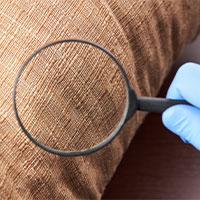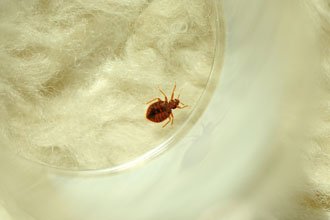What do bedbugs look like?
How to identify these unwanted houseguests

Recognizing the appearance of bedbugs is crucial in promptly addressing a potential infestation. These pervasive pests, known for causing considerable distress and discomfort, are a frequent concern in many households, and learning to identify them can help you know when it’s time to call a pest control company.
Key insights
- Adult bedbugs are brown, oval-shaped and about the size of an apple seed. Their bodies swell and turn purplish-red after a blood meal.
- Infant bedbugs, or nymphs, are smaller and lighter in color than adults and darken as they grow.
- Bedbugs have distinct life and feeding cycles, with each stage requiring a blood meal for growth and development.
- Bedbugs are elusive and prefer to hide in dark, secluded spaces, including mattress seams, furniture cracks and wall gaps.
How to identify bedbugs
Bedbugs, despite their small size, have distinct characteristics that can help you identify them, although you should keep in mind that their appearance can change slightly depending on their life stage.
What do adult bedbugs look like?

Adult bedbugs are about the size of an apple seed (usually around 4 to 5 millimeters long). Bedbugs that have not fed recently are brown with a flat, oval-shaped body. After feeding, their bodies swell and turn a purplish-red color.
“Note that bedbugs have distinct body features, including six legs, two antennae and a segmented abdomen,” said Nicole Carpenter, president of Black Pest Protection in Charlotte, North Carolina. “The front part of their body is narrower compared to the back.”
What do infant bedbugs look like?
Infant bedbugs, known as nymphs, are smaller than adults and lighter in color, making them even harder to spot. As they grow, they shed their skin, a process known as molting, and become darker.
Common hiding places for bedbugs
Bedbugs are known for their elusive behavior and prefer to hide in dark, secluded spaces. They commonly hide in places such as the seams and tags of mattresses, cracks in furniture and gaps in walls. They can also be found in the seams of chairs and couches, between cushions and in the folds of curtains.
» LEARN: How to check for bedbugs
Life and feeding cycles of bedbugs
Bedbugs have three main stages in their life cycle: egg, nymph and adult. They feed on blood, and their feeding habits can influence their growth and development. Bedbugs require a blood meal to molt and progress to their next life stage.
They are primarily active at night, and their feeding can take three to 12 minutes.
» DISCOVER: What do bedbug bites look like?
What to do if you spot bedbugs
If you spot bedbugs in your home, it's crucial to act quickly to prevent a full-blown infestation. Start by isolating the affected areas to prevent the pests from spreading to other parts of your home. Next, consider contacting a pest control professional for a thorough inspection and treatment plan — while it’s possible to treat bedbugs on your own, it can be a difficult process.
“Bedbugs are resilient pests that can quickly multiply and spread throughout your home, making eradication difficult without professional help,” Carpenter of Black Pest Prevention said. “While it may be tempting to try DIY methods, it is often more effective and efficient to hire a professional pest control company with experience in bedbug extermination.”
» DO IT RIGHT: How to get rid of bedbugs
FAQ
Can bedbugs be seen with the naked eye?
Adult bedbugs can be seen with the naked eye. However, their small size and tendency to hide make them difficult to spot.
What color are bedbugs?
Bedbugs are typically brown, but their color can change to a purplish-red after feeding.
How can I differentiate between bedbugs and other similar insects?
Bedbugs have distinct characteristics, such as their flat, oval-shaped body, brown color and banded appearance due to microscopic hairs. Other insects may have different shapes, sizes and color patterns.
You’re signed up
We’ll start sending you the news you need delivered straight to you. We value your privacy. Unsubscribe easily.